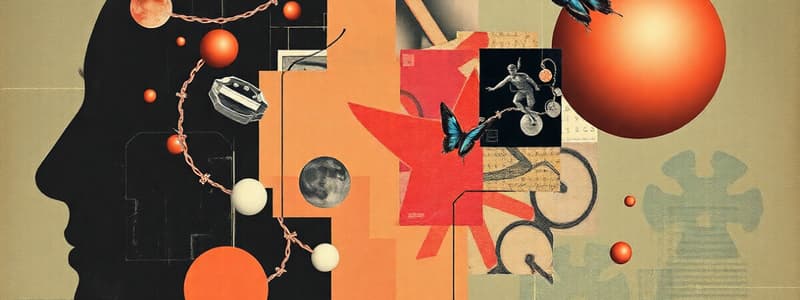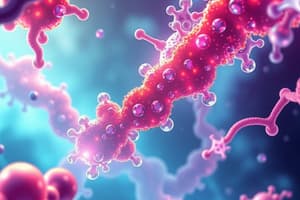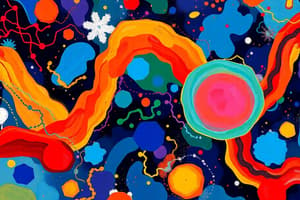Podcast
Questions and Answers
What is the effect of a negative allosteric modulator (NAM) on the dose-response curve?
What is the effect of a negative allosteric modulator (NAM) on the dose-response curve?
- Shifts the curve to the left, increasing potency.
- Does not affect the dose-response curve.
- Shifts the curve to the right, decreasing potency. (correct)
- Shifts the curve to the left, decreasing potency.
Which type of receptor is involved in the signaling pathway of a partial agonist?
Which type of receptor is involved in the signaling pathway of a partial agonist?
- Ligand-gated channels
- Enzyme-linked receptors
- Nuclear receptors
- Metabotropic receptors (correct)
What is the relationship between potency and EC50?
What is the relationship between potency and EC50?
- EC50 and potency are not related.
- Higher EC50 indicates lower efficacy.
- Lower EC50 indicates lower potency. (correct)
- Higher EC50 indicates higher potency.
What is the primary function of a competitive antagonist?
What is the primary function of a competitive antagonist?
Which of the following is a characteristic of a full agonist?
Which of the following is a characteristic of a full agonist?
What is the effect of receptor desensitization on a drug's efficacy?
What is the effect of receptor desensitization on a drug's efficacy?
Which of the following is an example of a partial agonist?
Which of the following is an example of a partial agonist?
What is the mechanism of action of antihistamines?
What is the mechanism of action of antihistamines?
Which type of receptor is characterized by a central pore that opens and closes in response to ions?
Which type of receptor is characterized by a central pore that opens and closes in response to ions?
What is the function of the G-protein in G-protein coupled receptors?
What is the function of the G-protein in G-protein coupled receptors?
What is the primary characteristic of an allosteric modulator?
What is the primary characteristic of an allosteric modulator?
How does a positive allosteric modulator (PAM) affect the efficacy of an agonist?
How does a positive allosteric modulator (PAM) affect the efficacy of an agonist?
What is the purpose of spare receptors in a system?
What is the purpose of spare receptors in a system?
Which of the following is NOT a characteristic of an allosteric modulator?
Which of the following is NOT a characteristic of an allosteric modulator?
What is the primary difference between a partial agonist and an inverse agonist?
What is the primary difference between a partial agonist and an inverse agonist?
Which type of receptor is typically involved in the signaling pathway of steroid hormones?
Which type of receptor is typically involved in the signaling pathway of steroid hormones?
What is the intrinsic activity value of an inverse agonist?
What is the intrinsic activity value of an inverse agonist?
Which statement is correct regarding the effect of antagonists?
Which statement is correct regarding the effect of antagonists?
What does the law of mass action state about the relationship between drug occupancy and response?
What does the law of mass action state about the relationship between drug occupancy and response?
What is the primary significance of the dissociation constant (Kd)?
What is the primary significance of the dissociation constant (Kd)?
How do inverse agonists interact with agonists?
How do inverse agonists interact with agonists?
Why is drug selectivity important when designing drugs for receptor channels?
Why is drug selectivity important when designing drugs for receptor channels?
Which statement best describes the Langmuir equation?
Which statement best describes the Langmuir equation?
What does Bmax represent in receptor theory?
What does Bmax represent in receptor theory?
Which of these is a characteristic of benzodiazepines?
Which of these is a characteristic of benzodiazepines?
What does the binding of benzodiazepines at the alpha-gamma subunits affect?
What does the binding of benzodiazepines at the alpha-gamma subunits affect?
How is the concentration of receptors expressed in relation to Kd and drug-receptor complexes?
How is the concentration of receptors expressed in relation to Kd and drug-receptor complexes?
Which drugs target the alpha-5 subunit of GABA receptors?
Which drugs target the alpha-5 subunit of GABA receptors?
Which of the following statements about drug-receptor interactions is false?
Which of the following statements about drug-receptor interactions is false?
What happens when Kd equals the drug concentration?
What happens when Kd equals the drug concentration?
What type of ligand binds to the inactive state of a receptor?
What type of ligand binds to the inactive state of a receptor?
What key concept does the occupancy theory emphasize?
What key concept does the occupancy theory emphasize?
What is the relationship between receptor occupancy and tissue response?
What is the relationship between receptor occupancy and tissue response?
What happens to the dose-response curve if a drug binds less tightly?
What happens to the dose-response curve if a drug binds less tightly?
How is intrinsic activity measured in drugs?
How is intrinsic activity measured in drugs?
What is the alpha value for a partial agonist?
What is the alpha value for a partial agonist?
Which type of antagonist binds to the same site as an agonist?
Which type of antagonist binds to the same site as an agonist?
What effect does a non-competitive antagonist have on the Emax?
What effect does a non-competitive antagonist have on the Emax?
How does intrinsic efficacy relate to receptor occupancy?
How does intrinsic efficacy relate to receptor occupancy?
What does an alpha value of -1 signify for a drug?
What does an alpha value of -1 signify for a drug?
What effect does changing the Koff have on the Kon if Kd remains constant?
What effect does changing the Koff have on the Kon if Kd remains constant?
For a full agonist, which statement is true?
For a full agonist, which statement is true?
When the drug concentration equals Kd, what percentage of Emax is achieved?
When the drug concentration equals Kd, what percentage of Emax is achieved?
Which of the following defines a competitive antagonist?
Which of the following defines a competitive antagonist?
What happens to the dose-response curve if potency increases?
What happens to the dose-response curve if potency increases?
In which scenario does a partial agonist act differently than a full agonist?
In which scenario does a partial agonist act differently than a full agonist?
What does the term Emax refer to in the context of inverse agonists?
What does the term Emax refer to in the context of inverse agonists?
In receptor pharmacology, what characteristic differentiates a partial agonist from a full agonist?
In receptor pharmacology, what characteristic differentiates a partial agonist from a full agonist?
What effect do non-competitive antagonists have on Emax when spare receptors are present?
What effect do non-competitive antagonists have on Emax when spare receptors are present?
Which of the following is true regarding spare receptors?
Which of the following is true regarding spare receptors?
What is a primary characteristic of full agonists?
What is a primary characteristic of full agonists?
Which condition is necessary to determine if drugs have the same mechanism of action?
Which condition is necessary to determine if drugs have the same mechanism of action?
Which of the following represents a common non-receptor-mediated mechanism of action?
Which of the following represents a common non-receptor-mediated mechanism of action?
In the presence of a full agonist, how does a partial agonist behave?
In the presence of a full agonist, how does a partial agonist behave?
If all receptors must be occupied to reach Emax, what can be said about the relationship between EC50 and KD?
If all receptors must be occupied to reach Emax, what can be said about the relationship between EC50 and KD?
Which drug is a full agonist at opioid receptors?
Which drug is a full agonist at opioid receptors?
What role do enzymes play in drug action?
What role do enzymes play in drug action?
Which of the following statement about EC50 is accurate regarding spare receptors?
Which of the following statement about EC50 is accurate regarding spare receptors?
When comparing analgesics, what differentiates ibuprofen from morphine?
When comparing analgesics, what differentiates ibuprofen from morphine?
Flashcards
Occupancy Theory
Occupancy Theory
Theory stating that the effect of a drug is proportional to the number of receptors occupied.
Law of Mass Action
Law of Mass Action
Principle that drug response correlates to receptor occupancy and follows a 'lock-and-key' model.
Dissociation Constant (Kd)
Dissociation Constant (Kd)
A value representing the affinity of a drug for its receptor, calculated as Kd = Koff / Kon.
Binding Affinity
Binding Affinity
Signup and view all the flashcards
Langmuir Equation
Langmuir Equation
Signup and view all the flashcards
Bmax
Bmax
Signup and view all the flashcards
Intrinsic Activity
Intrinsic Activity
Signup and view all the flashcards
Equilibrium in Drug-Receptor Interactions
Equilibrium in Drug-Receptor Interactions
Signup and view all the flashcards
Receptor Occupancy
Receptor Occupancy
Signup and view all the flashcards
Intrinsic Efficacy
Intrinsic Efficacy
Signup and view all the flashcards
Dose-Response Curve
Dose-Response Curve
Signup and view all the flashcards
Kd (Dissociation Constant)
Kd (Dissociation Constant)
Signup and view all the flashcards
Alpha Factor
Alpha Factor
Signup and view all the flashcards
Full Agonist
Full Agonist
Signup and view all the flashcards
Partial Agonist
Partial Agonist
Signup and view all the flashcards
Antagonist
Antagonist
Signup and view all the flashcards
Inverse Agonist
Inverse Agonist
Signup and view all the flashcards
Competitive Antagonist
Competitive Antagonist
Signup and view all the flashcards
Non-Competitive Antagonist
Non-Competitive Antagonist
Signup and view all the flashcards
Potency
Potency
Signup and view all the flashcards
Mass Action Law
Mass Action Law
Signup and view all the flashcards
Receptor Theory
Receptor Theory
Signup and view all the flashcards
Receptor State
Receptor State
Signup and view all the flashcards
Allosteric Modulator
Allosteric Modulator
Signup and view all the flashcards
Benzodiazepines
Benzodiazepines
Signup and view all the flashcards
GABA-A Receptors
GABA-A Receptors
Signup and view all the flashcards
Isoform Selectivity
Isoform Selectivity
Signup and view all the flashcards
Receptor
Receptor
Signup and view all the flashcards
Affinity
Affinity
Signup and view all the flashcards
Agonist
Agonist
Signup and view all the flashcards
Orthosteric Binding Site
Orthosteric Binding Site
Signup and view all the flashcards
Efficacy
Efficacy
Signup and view all the flashcards
EC50
EC50
Signup and view all the flashcards
Positive Allosteric Modulator (PAM)
Positive Allosteric Modulator (PAM)
Signup and view all the flashcards
Negative Allosteric Modulator (NAM)
Negative Allosteric Modulator (NAM)
Signup and view all the flashcards
Alpha Values
Alpha Values
Signup and view all the flashcards
Stereoselectivity
Stereoselectivity
Signup and view all the flashcards
Spare Receptors
Spare Receptors
Signup and view all the flashcards
Beta-Blockers
Beta-Blockers
Signup and view all the flashcards
Dopamine Response
Dopamine Response
Signup and view all the flashcards
Emax vs KD
Emax vs KD
Signup and view all the flashcards
Mechanism of Action
Mechanism of Action
Signup and view all the flashcards
Clinical Importance of Spare Receptors
Clinical Importance of Spare Receptors
Signup and view all the flashcards
Abbreviated Terms: kon and koff
Abbreviated Terms: kon and koff
Signup and view all the flashcards
Study Notes
Occupancy Theory
- Developed over 100 years ago, observing dye staining specific tissues.
- More dye concentration equates to more staining, leading to the concept of molecules targeting specific sites.
Law of Mass Action
- One drug molecule binds to one receptor molecule and vice versa.
- Response is proportional to occupancy.
- Binding is reversible; negligible drug use implies excess for uniform receptor concentration sensing.
Terms
- [D]: Free drug concentration.
- [R]: Free receptor concentration.
- [DR]: Concentration of drug-receptor complex.
- [DR] + [R] = Total number of receptors.
Drug-Receptor Interactions
- Drug interacts with receptor, reaching equilibrium, forming an activated drug-receptor complex.
- Activated complex leads to response based on intrinsic activity.
- Kon: Rate of drug binding to receptor.
- Koff: Rate of drug dissociation from receptor.
Dissociation Constant (Kd)
- Kd: Measures drug affinity for receptor.
- Kd = Koff / Kon
- Kd = ([D] x [R]) / [DR]
Langmuir Equation
- Relates percent maximal response to drug concentration.
- % Emax = (D / (Kd + D)) x 100
- If Kd = drug concentration, response is 50% of Emax.
Bmax
- Bmax: Total number of receptors; maximal binding.
- Achieved when all receptor sites are occupied.
- Emax is reached when all receptors are bound.
Relationship Between Receptor Occupancy and Tissue Response
- Tissue response is a function of receptor occupancy.
- Langmuir equation describes receptor occupancy.
- Receptor occupancy correlates with drug activation and number of receptors.
- 50% binding yields a 50% response.
Dose-Response Curve
- If Kd = drug concentration, response is 50% of Emax.
- Curve displays 100-fold concentration change (10% to 90% response).
- Changing potency shifts the curve.
- Higher Koff leads to higher Kd and a rightward shift (lower potency).
- Lower Koff leads to lower Kd and a leftward shift (higher potency).
Intrinsic Activity
- All drugs don't activate receptors equally.
- Intrinsic activity assesses how a drug activates a receptor.
- Measured by an alpha factor.
Modified Langmuir Equation
- % Emax = α x (D / (Kd + D)) x 100
- Alpha values: Assess intrinsic activity.
Drug Classes Based on Intrinsic Activity
- Full Agonist (α = 1): Maximal response.
- Partial Agonist (0 < α < 1): Submaximal response.
- Antagonist (α = 0): No response.
- Inverse Agonist (-1 < α < 0): Opposite effect.
Full Agonists
- Bind to receptor, fully activate, achieve maximal response (Emax = Bmax).
- Have an α value of 1.
- Potency determined by EC50, but have equal slopes and Emax.
Partial Agonists
- Bind to receptor, produce partial response.
- Never reach maximal response.
- Potency & Emax differ from full agonists.
Antagonists
- α value of 0.
- Block agonist activation of the receptor.
Competitive Antagonists
- Bind to same site as agonist.
- Rightward shift in dose-response curve; EC50 changes, but Emax stays same.
- Reversible binding.
Non-Competitive Antagonists
- Bind irreversibly, or bind to a different site.
- Reduce Emax, regardless of agonist concentration.
- Irreversible binding; agonist cannot reach Emax.
Spare Receptors
- Receptors not fully occupied to achieve maximal response.
- Magnitude of response isn't proportional to receptor occupancy.
- Emax achievable without occupying all receptors.
Experimental Observation of Spare Receptors
- EC50 and Kd values differ when spare receptors present.
- If all receptors needed, EC50 = Kd.
- If fraction of receptors needed, EC50 < Kd.
Effect of Non-Competitive Antagonists
- Reduce Emax due to inability of agonist to overcome antagonist.
- With spare receptors, low concentrations of non-competitive antagonists don't affect Emax Initially, looking like competitive antagonists.
- High concentration reduces Emax.
Clinical Importance of Spare Receptors
- Protect against disease or irreversible antagonists.
Receptor Binding and Activation
- Receptor interacts with ligand.
- Affinity: Ligand binding strength.
- Agonist: Activates receptor, producing response.
- Antagonist: Prevents response.
Comparing Ligand Activities
- Potency: Drug concentration for maximal effect.
- EC50: Drug concentration for 50% maximal effect.
- Efficacy: Maximal response achievable by a drug.
- Emax: Maximal response.
Agonist Mode of Action
- Full agonist: Stabilizes active state, maximal response.
- Partial agonist: Stabilizes intermediate state, submaximal response.
- Inverse agonist: Stabilizes inactive state, opposite effect.
- Antagonist: Blocks receptor, no response.
Allosteric Modulators
- Bind to different site from orthosteric site.
- Modulate ligand effect.
- Positive PAM increases, Negative NAM decreases response.
- Silent SAMs have no effect on activity.
Receptor Classes
- Ligand-gated channels, metabotropic receptors, nuclear receptors, enzyme-linked receptors.
G-Protein Coupled Receptors (GPCRs)
- Transduce signals.
- Target hormones/neurotransmitters.
- Couple with effector system to mediate signaling.
Case Studies: Modes of Action
- Opioid receptor example (partial agonist Buprenorphine).
- Histamine receptor example (inverse agonist antihistamines).
Comparing Inverse Agonists and Antagonists
- Inverse agonist reduces/blocks receptor activity by binding to inactive state; can block agonist, not inverse agonist.
- Antagonist blocks agonist, and blocks inverse agonist; does not elicit a receptor response.
Ligand-Gated Ion Channels
- Drug binding opens ion channels (selective ions).
- Modulate membrane potential.
GABA-A Receptors and Benzodiazepines
- Benzodiazepines are allosteric modulators.
Module Summary
- Covered agonist types (full, partial, inverse).
- Defined intrinsic activity, allosteric modulators, and receptor classes.
- Presented case studies demonstrating different modes of action.
Studying That Suits You
Use AI to generate personalized quizzes and flashcards to suit your learning preferences.



